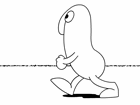One of the most common and most puzzling problems a network engineer/technician may face is what is the PROPER way to make up a 10BaseT cable. Usually, to confound the learning process, someone introduces the need for a reversed or cross-over cable at the same time. What these are and how to make them is the subject of this on-line tutorial.
Selection of Cabling Category
Since the overwhelming bulk of network cabling done today uses Unshielded Twisted Pair (UTP) wiring that is what we will discuss. The process begins with the selection of the proper wiring level or category. Today it is basically inexcusable to use or install anything at less than
While technically Category 5 and Level V are not the same, they are identical in practice. Both support upto 100 megabit per second data transmission, and their physical cable assembly requirements are the same. Throughout this tutorial we will refer to them both as CAT5.
When you order CAT5 unshielded twisted pair (UTP) cable you will receive a cable containing 4 twisted pairs of wires, a total of 8 wires. The strands that constitute each wire will either be a single strand or multiple strands, usually referred to as solid or flex. Typically the solid is used to run through walls and ceilings and the flex is used to make drop cables (the cable from the wall plate to the desktop computer) and patch cables (the cable from the patch panel to the hub). Whether the exterior portion of the cable that contains the 4 twisted pairs, the jacket, is Plenum grade or Non-plenum grade is very important, it refers to the Fire Codes, but is outside the scope of this tutorial.
Ordering Pairs
The pairs of wires in UTP cable are colored so that you can identify the same wire at each end. Furthermore, they are usually color coded by pair so that the pairs can also be identified from end to end. Typical CAT5 UTP cables contain 4 pairs made up of a solid color and the same solid color striped onto a white background. The most common color scheme is the one that corresponds to the Electronic Industry Association/Telecommunications Industry Association's Standard 568B.
The following table demonstrates the proper color scheme.
| Wire pair #1: | White/Blue Blue |  |
| Wire pair #2: | White/Orange Orange | |
| Wire pair #3: | White/Green Green | |
| Wire pair #4: | White/Brown Brown |
Connectors
The cable connectors and jacks that are most commonly used with CAT5 UTP cables are RJ45. The RJ simply means Registered Jack and the 45 designation specifies the pin numbering scheme. The connector is attached to the cable and the jack is the device that the connector plugs into, whether it is in the wall, the network interface card in the computer, or the hub.
Now that we are ready to insert the cable into the RJ45 plug the wire number and color sequence becomes more complicated.
The IEEE Specification for Ethernet 10BaseT requires that two twisted pairs be used and that one pair is connected to pins 1 and 2, and that the second pair is connected to pins 3 and 6. Yes that is right - pins 4 and 5 are skipped and are connected to one of the remaining twisted pairs.
According to the EIA/TIA-568B RJ-45 Wiring Scheme:
It gets even more odd because wire Pair#2 (white/orange, orange) and Pair#3 (white/green, green) are the only two pairs used for 10BaseT data.
| Pair#2 is connected to pins 1 and 2 like this: | |
| Pin 1 wire color: | white/orange |
| Pin 2 wire color: | orange |
| Pair#3 is connected to pins 3 and 6 like this: | |
| Pin 3 wire color: | white/green |
| Pin 6 wire color: | green |
| Pair#1 | |
| Pin 4 wire color: | blue |
| Pin 5 wire color: | white/blue |
| Pair#4 | |
| Pin 7 wire color: | white/brown |
| Pin 8 wire color: | brown |
This is illustrated in the following diagram:

Now the wires forming the pairs must be gathered together and trimmed so that they can be inserted into the RJ45 plug. The pairs gathered and trimmed is illustrated in the following diagram:

Then when the pairs are inserted into the RJ45 plug they should look like this:

In order to make what is commonly referred to as a "Crossover" cable one must change the pinout connections on ONE end of the cable. If you do it on both ends of the cable you have crossed-over the crossover and now have a straight-through cable, albeit a very non-standard one. In this case two negatives do make a positive.
You need to make a cable where pins 1 & 2 from one end are connected to pins 3 & 6 on the other end, and pins 3 & 6 from the first end are connected to pins 1 & 2 on the other end. Pins 4 & 5 and 7 & 8 are unchanged.
The two ends look like this:
Standard End Crossover End
Pin 1 White/Orange Pin 1 White/Green
Pin 2 Orange Pin 2 Green
Pin 3 White/Green Pin 3 White/Orange
Pin 4 Blue Pin 4 Blue
Pin 5 White/Blue Pin 5 White/Blue
Pin 6 Green Pin 6 Orange
Pin 7 White/Brown Pin 7 White/Brown
Pin 8 Brown Pin 8 Brown
The following is the proper pin out and cable pair/color order for the
| Pair#2 is connected to pins 1 and 2 like this: | |
| Pin 1 wire color: | white/green |
| Pin 2 wire color: | green |
| Pair#3 is connected to pins 3 and 6 like this: | |
| Pin 3 wire color: | white/orange |
| Pin 6 wire color: | orange |

Then when the pairs are inserted into the RJ45 plug they should look like this:

Note: Even though we are only interested in attaching the connectors to the cable in this tutorial, we must take into account the wiring of the jacks as well so that we connect the proper wires from the cable to the proper pins in the connectors. And that is determined by the wiring in the jack the connectors will be plugged into.































0 komentar:
Post a Comment